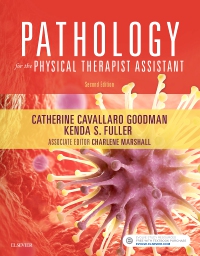
Pathology for the Physical Therapist Assistant - Elsevier eBook on VitalSource, 2nd Edition
Elsevier eBook on VitalSource

This landmark PTA-specific pathology text is back and better than ever! Like its previous edition, Goodman and Fuller’s Pathology Essentials for the Physical Therapist Assistant, 2nd Edition offers an intervention-focused guide to disease processes and disorders with the specific needs of the physical therapy assistant in mind. Within each chapter you’ll find a consistent, well-organized approach that defines each pathology disorder, describes the appropriate physical therapy assessment and intervention, and rounds out the discussion with relevant case study examples based on established practice patterns. Along with this critical information, this second edition also boasts a number of changes and additions to make it even more relevant for the PTA student, including: more streamlined content to keep the focus on what is most applicable to the physical therapist assistant; new critical thinking questions and clinical scenarios on Evolve to help students better apply what they are learning to actual practice; and an easily recognizable medical management section that addresses diagnosis, treatment and prognosis for each condition discussed.
Newer Edition Available
Goodman and Fuller’s Pathology for the Physical Therapist Assistant Elsevier eBook on VitalSource
-
- PTA-specific information and reading level provides easy-to-follow guidance that is specific to the role of the PTA in managing patients
- NEW! Vocab builders set the stage by framing upcoming information in the text
- NEW! Course objectives can be used by instructors as a quick reference list to help formulate their own "course objectives."
- NEW! Critical thinking questions on the Evolve companion website help students apply the knowledge gained from the text and help facilitate active class participation
- NEW! Clinical scenarios on the Evolve companion website look at patients who have variety of comorbidities and the many factors to consider when evaluating and treating
- Special Implications for the PTA sections offer a starting point when addressing a particular condition for the first time
- Medical management section that is set off for easy recoginition within the text addresses diagnosis, treatment and prognosis for each condition discussed
- Easy-to-follow, consistent format features a well-organized approach that defines each disorder followed by sections on clinical manifestations and medical management
- Coverage of basic science information and the clinical implications of disease within the rehabilitation process gives students a solid background in common illnesses and diseases, adverse effects of drugs, organ transplantation, laboratory values, and much more
- More than 700 full-color images help reinforce understanding of disease conditions and general pathology principles
- Terminology and language from the Guide to Physical Therapy Practice is used throughout to familiarize students with standardized terminology used in practice
- NEW! New editor Charlene Marshall brings both an instructional and practicing PTA to the text
- Twelve e-chapters offer supplemental information in the areas of behavioral issues, the gastrointestinal system, vestibular disorders and more
- Abundance of tables and boxes organize and summarize important points to make it easy for students to access key information
-
- NEW! Clinical scenarios on the Evolve companion website look at patients who have variety of comorbidities and the many factors to consider when evaluating and treating
- NEW! Critical thinking questions on the Evolve companion website help users apply the knowledge gained from the text
- NEW! Vocab builders set the stage by framing upcoming information in the text
-
Section 1: Introduction
1. Introduction to Concepts of Pathology
2. Problems Affecting Multiple Systems
3. Injury, Inflammation, and Healing
Section 2: Clinical Medicine
4. The Immune System
5. Infectious Disease
6. Oncology
7. The Integumentary System
8. The Endocrine and Metabolic Systems
9. The Cardiovascular System
10. The Hematologic System
11. The Respiratory System
12. The Hepatic, Pancreatic, and Biliary Systems
Section 3: Pathology of the Musculoskeletal System
13. Introduction to Pathology of the Musculoskeletal System
14. Genetic and Developmental Disorders
15. Infectious Diseases of the Musculoskeletal System
16. Musculoskeletal Neoplasms
17. Bone, Joint, and Soft Tissue Diseases and Disorders
Section 4: Pathology of the Nervous System
18. Introduction to Central Nervous System Disorders
19. Infectious Disorders of the Central Nervous System
20. Degenerative Diseases of the Central Nervous System
21. Stroke
22. Traumatic Brain Injury
23. Traumatic Spinal Cord Injury
24. Cerebral Palsy
25. The Peripheral Nervous System
Evolve E-Chapters
1. Behavioral, Social, and Environmental Factors Contributing to Disease and Dysfunction
2. The Psychosocial-Spiritual Impact on Health Care
3. Environmental and Occupational Medicine
4. The Gastrointestinal System
5. The Renal and Urologic Systems
6. Central Nervous System Neoplasms
7. Epilepsy
8. Headache
9. The Male Genital or Reproductive System
10. The Female Genital or Reproductive System
11. Vestibular Disorders
12. Laboratory Tests and ValuesAppendix A: Summary of Standard Precautions
Appendix B: Guidelines for Activity and Exercise


 as described in our
as described in our 